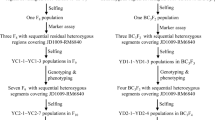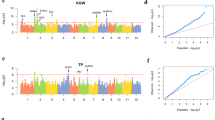Abstract
Grain weight is a major determinant of crop grain yield and is controlled by naturally occurring quantitative trait loci (QTLs). We earlier identified a major QTL that controls rice grain width and weight, GW5, which was mapped to a recombination hotspot on rice chromosome 5. To gain a better understanding of how GW5 controls rice grain width, we conducted fine mapping of this locus and uncovered a 1 212-bp deletion associated with the increased grain width in the rice cultivar Asominori, in comparison with the slender grain rice IR24. In addition, genotyping analyses of 46 rice cultivars revealed that this deletion is highly correlated with the grain-width phenotype, suggesting that the GW5 deletion might have been selected during rice domestication. GW5 encodes a novel nuclear protein of 144 amino acids that is localized to the nucleus. Furthermore, we show that GW5 physically interacts with polyubiquitin in a yeast two-hybrid assay. Together, our results suggest that GW5 represents a major QTL underlying rice width and weight, and that it likely acts in the ubiquitin-proteasome pathway to regulate cell division during seed development. This study provides novel insights into the molecular mechanisms controlling rice grain development and suggests that GW5 could serve as a potential tool for high-yield breeding of crops.
Similar content being viewed by others
Log in or create a free account to read this content
Gain free access to this article, as well as selected content from this journal and more on nature.com
or
References
Rosegrant MW, Cline SA . Global food security: challenges and policies. Science 2003; 302:1917–1919.
Luo YK, Zhu ZW, Chen N, Duan BW, Zhang LP . Grain types and related quality characteristics of rice in China. Chin J Rice Sci 2004; 18:135–139.
Xu JY, Xue QZ, Luo LJ, Li ZK . Genetic dissection of grain weight and its related traits in rice (Oryza sativa L.). Chin J Rice Sci 2002; 16:6–10.
Aluko G, Martinez C, Tohme J, et al. QTL mapping of grain quality traits from the interspecific cross Oryza sativa×O. glaberrima. Theor Appl Genet 2004; 109:630–639.
Redoña ED, Mackill DJ . Quantitative trait locus analysis for rice panicle and grain characteristics. Theor Appl Genet 1998; 96:957–963.
Huang N, Parco A, Mew T, et al. RFLP mapping of isozymes, RAPD and QTLs for grain shape, brown planthopper resistance in a doubled haploid rice population. Mol Breeding 1997; 3:105–113.
Lin HX, Min SK, Xiong ZM, et al. RFLP mapping of QTLs for grain shape traits in indica rice (Oryza sativa L. subsp. Indica). Sci Agric Sin 1995; 28:1–7.
Tan YF, Xing YZ, Li JX, et al. Genetic bases of appearance quality of rice grains in Shanyou 63, an elite rice hybrid. Theor Appl Genet 2000; 101:823–829.
Xu JL, Xue QZ, Luo LJ, Li ZK . Genetic dissection of grain weight and its related traits in rice (Oryza sativa L.). Chin J Rice Sci 2002; 16:6–10.
Li JM, Xiao JH, Grandillo S, et al. QTL detection for rice grain quality traits using an interspecific backcross population derived from cultivated Asian (O. Sativa L.) and African (O. glaberrium S.) rice. Genome 2004; 47:697–704.
Ashikari M, Sakakibara H, Lin SY, et al. Cytokinin oxidase regulates rice grain production. Science 2005; 309:741–745.
Xue WY, Xing YZ, Weng XY, et al. Natural variation in Ghd7 is an important regulator of heading date and yield potential in rice. Nat Genet 2008; 40:761–767.
Fan CC, Xing YZ, Mao HL, et al. GS3, a major QTL for grain length and weight and minor QTL for grain width and thickness in rice, encodes a putative transmembrane protein. Theor Appl Genet 2006; 112:1164–1171.
Song XJ, Huang W, Shi M, Zhu MZ, Lin HX . A QTL for rice grain width and weight encodes a previously unknown RING-type E3 ubiquitin ligase. Nat Genet 2007; 39:623–630.
Li YH, Zheng LY, Corke F, Smith C, Bevan MW . Control of final seed and organ size by the DA1 gene family in Arabidopsis thaliana. Genes Dev 2008; 22:1331–1336.
Schruff MC, Spielman M, Tiwari S, Adams S, Fenby N, Scott RJ . The AUXIN RESPONSE FACTOR 2 gene of Arabidopsis links auxin signaling, cell division, and the size of seeds and other organs. Development 2006; 133:251–261.
Tanabe S, Ashikari M, Fujikoka S, et al. A novel cytochrome P450 is implicated in brassinosteroid biosynthesis via the characterization of a rice dwarf mutant, dwarf11, with reduced seed length. Plant Cell 2005; 17:776–790.
Riefler M, Novak O, Strnad M, Schmu T . Arabidopsis cytokinin receptor mutants reveal functions in shoot growth, leaf senescence, seed size, germination, root development, and cytokinin metabolism. Plant Cell 2006; 18:40–54.
Ashikari M, Wu JZ, Yano M, Saski T, Yoshimura A . Rice gibberellin-insensitive dwarf mutant gene Dwarf 1 encodes the a-subunit of GTP-binding protein. Proc Natl Acad Sci USA 1999; 96:10284–10289.
Kim JY, Mahe A, Brangeon J, Prioul JL . Maize vacuolar invertase, IVR2, is induced by water stress organ/tissue specificity and diurnal modulation of expression. Plant Physiol 2000; 124:71–84.
Martin A, Lee J, Kichey T, et al. Two cytosolic glutamine synthetase isoforms of maize are specifically involved in the control of grain production. Plant Cell 2006; 18:3252–3274.
Kato S, Kosaka H, Hara S . On the affinity of rice varieties as shown by fertility of hybrid plants. Bull Sci Fac Agric 1928; 3:132–147.
Khush GS . Origin, dispersal, cultivation and variation of rice. Plant Mol Biol 1997; 35:25–34.
Zhu QH, Ge S . Phylogenetic relationships among A-genome species of the genus Oryza revealed by intron sequences of four nuclear genes. New Phytol 2005; 167:249–265.
Ting Y . The origin and evolution of cultivated rice in China. Acta Agron Sin 1957; 8:243–260.
Doebley J, Stec A, Hubbard L . The evolution of apical dominance in maize. Nature 1997; 386:485–488.
Frary An, Nesbitt TC, Frary Am, et al. fw2.2: A quantitative trait locus key to the evolution of tomato fruit size. Science 2000; 289:85–88.
Liu JP, Eck JV, Cong B, Tanksley SD . A new class of regulatory genes underlying the cause of pear-shape tomato fruit. Proc Natl Acad Sci USA 2002; 99:13302–13306.
Konishi S, Izawa T, Lin SY, et al. An SNP caused loss of seed shattering during rice domestication. Science 2006; 312:1392–1396.
Li CB, Zhou AL, Sang T . Rice domestication by reducing shattering. Science 2006; 311:1936–1939.
Wan XY, Weng JF, Zhai HQ, et al. Fine mapping of the key allele gw-5 of a grain-width QTL in a recombination hotspot region on rice chromosome 5. Genetics 2008; 179:2239–2252.
Tsunematsu H, Yoshimura A, Harushima Y, et al. RFLP framework map using recombinant inbred lines in rice. Breed Sci 1996; 46:279–284.
Kubo T, Nakamura K, Yoshimura A . Development of a series of Indica chromosome segment substitution lines in Japonica background of rice. Rice Genet Newslett 1999; 16:104–106.
Li L, Wang XF, Stolc V, et al. Genome-wide transcription analyses in rice using tiling microarrays. Nat Genet 2006; 38:124–128.
Harlan J . Crops & Man. Madison, WI: American Society of Agronomy/Crop Science Society of America, 1992.
Feng Q, Zhang Y, Hao P, et al. Sequence and analysis of rice chromosome 4. Nature 2002; 420:316–320.
Doebley J, Lukens L . Transcriptional regulators and the evolution of plant form. Plant Cell 1998; 10:1075–1082.
Van der Horst A, De Vries-Smits AMM, Brenkman AB, et al. FOXO4 transcriptional activity is regulated by monoubiquitination and USP7/HAUSP. Nat Cell Biol 2006; 8:1064–1073.
Zhang D, Zaugg K, Mak T, Elledge S . A role for the deubiquitinating enzyme USP28 in control of the DNA-damage response. Cell 2006; 126:529–542.
Sridhar VV, Kapoor A, Zhang K, et al. Control of DNA methylation and heterochromatic silencing by histone H2B deubiquitination. Nature 2007; 447:735–738.
Dellaporta SL, Wood J, Hicks JB . A plant DNA mini preparation: Version II. Plant Mol Biol Rep 1983; 1:19–21.
Chen X, Temnykh S, Xu Y, Cho YG, McCouch SR . Development of a microsatellite framework map providing genome-wide coverage in rice (Oryza sativa L.). Theor Appl Genet 1997; 95:553–567.
Sanguinetti CJ, Dias NE, Simpson AJG . Rapid silver staining and recover of PCR products separated on polyacrylamide gels. Biotechniques 1994; 17:915–919.
Thiel T, Kota R, Grosse I, Stein N, Graner A . SNP2CAPS: a SNP and INDEL analysis tool for CAPS marker development. Nucleic Acids Res 2004; 32:e5.
Zhang QF, Shen BZ, Dai XK, Mei MH, Maroof MAS, Li ZB . Using bulked extremes and recessive class to map genes for photoperiod-sensitive genic male sterility in rice. Proc Natl Acad Sci USA 1994; 91:8675–8679.
Shomura A, Izawa T, Ebana K . Deletion in a gene associated with grain size increased yields during rice domestication. Nat Genet 2008; 40:1023–1028.
Acknowledgements
This work was supported by grants from the National Basic Research Program of China (grant no. 2006CB101706) and the Hi-Tech Research and Development Program of China (863 Program) (grant no. 2006AA100101). We are grateful to Professor A Yoshimura, Kyushu University, Japan, for kindly providing us with the CSSL populations. We thank Dr Hai Yang Wang at the Boyce Thompson Institute of Cornell University for critically reading this paper. We also thank Dr Xing Wang Deng at the Department of Molecular, Cellular and Developmental Biology of Yale University for sharing the tiling array data of the 9311 cultivar.
Author information
Authors and Affiliations
Corresponding author
Rights and permissions
About this article
Cite this article
Weng, J., Gu, S., Wan, X. et al. Isolation and initial characterization of GW5, a major QTL associated with rice grain width and weight. Cell Res 18, 1199–1209 (2008). https://doi.org/10.1038/cr.2008.307
Received:
Revised:
Accepted:
Published:
Issue date:
DOI: https://doi.org/10.1038/cr.2008.307
Keywords
This article is cited by
-
T-DNA insertion mutants of Arabidopsis DA1 orthologous genes displayed altered plant height and yield-related traits in rice (O. Sativa L.)
Genes & Genomics (2024)
-
Natural variation of Grain size 3 allele differentially functions in regulating grain length in xian/indica and geng/japonica rice
Euphytica (2024)
-
Identification of qGL4.1 and qGL4.2, two closely linked QTL controlling grain length in rice
Molecular Breeding (2024)
-
Grain quality characteristics analysis and application on breeding of Yuenongsimiao, a high-yielding and disease-resistant rice variety
Scientific Reports (2023)
-
Structure and function of rice hybrid genomes reveal genetic basis and optimal performance of heterosis
Nature Genetics (2023)



